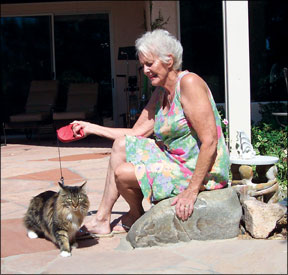Our lives with cats are usually quite personal and private. While many people adopt a dog to have a walking or hiking companion, cats are more often left at home to greet us after our day is done.
In fact, some people feel that it would be degrading to ask a cat to wear a leash and harness. True, a cats elegance and grace might be hampered with a restraint device of any type. Yet there

Bev Caldwell
288
are many reasons to consider teaching your cat to tolerate a leash.
For example, a leash is very often included as part of a behavior modification tool box. It can be used to facilitate the introduction of new pets as well as new people. Certain desensitization protocols rely on a leash for smooth and safe implementation. Another great benefit is that a leash-trained cat makes a wonderful sunbathing companion. Although I would not recommend falling asleep with a cat attached to your side, the leash will certainly allow the two of you to relax in the safety on your patio.
And what if, one day, your cat manages to gain an inordinate amount of weight despite your best intentions? Unfortunately, cats dont favor treadmills. But leash walking, whether done indoors or outside, will help burn up calories. And you might be surprised to learn that many gregarious, adventurous cats actually enjoy outdoor strolls with their families. I have met several people over the years with cats that happily participate in after-dinner walks.
Clearly, leash training offers many benefits. Before you get started, you will need to sort through the many styles of harnesses and leashes available. Choose a harness that you feel comfortable applying. If you must fumble or read the manual with each application, it is probably not a good choice for you. Use a toy animal to practice your technique.
Leash selection is less complicated. A bungee-style leash will allow your cat to play more freely while outdoors. This style of leash is suitable for indoor exercise and for exercise in the safety of your yard. A standard nylon leash allows you to control your cats boundaries more precisely. This would be important for walking around the neighborhood.
Don’t Rush the Process
Take your time introducing the apparatus. A cat that has ever threatened to bite or scratch when handled needs to be approached very carefully. Dont be shy about seeking professional guidance.Always abort your lesson if you feel that your cat is frightened or that he is about to bite or scratch you. Ask for assistance. Safety comes first.
Ready to begin? Begin by pairing the leash with play time. Bring the leash out along with one of your cats favorite toys. Let the leash touch your cat as he moves about so that the contact does not disturb him. Hold the leash as you walk around, encouraging him to follow you by using a toy as a lure. If he enjoys being brushed, then hold the leash in your hand as you brush him.
Set up separate sessions to introduce your cat to the harness. Be sure that your cat is accustomed to gentle restraint and handling. Use a soft towel to signal that you are about to do something with him and that he will be safe. If your cat is not aggressive or overly fearful, then put him on the towel and place his feet into the harness. Give him some treats, pet him and let him sniff the device. Repeat this every day for a few days. Just allow the harness to contact his body. As he becomes more comfortable, and as the harness begins to smell familiar, pull it up onto his chest and back and hold it gently in place. Give him some treats. After every two or three sessions – and as long as your cat seems relaxed – take another step forward. Your first endpoint is a loosely fastened harness. The straps can be tightened later.
At the end of each session, give a few treats and, as long as you feel safe, pick your cat up and hold him gently. Then remove the harness and let him go. He cannot roam about with the harness until the straps are tightened as he could get caught on something and panic. Once the straps are secured, he may wear the harness for play.
The final step will be simply to attach the leash. Practice in a relatively small room so he cannot run away and get hurt. With this step, you are nearly there! Fasten the harness, give him his treat and a gentle squeeze, fasten the leash, bring out his favorite toy and off you go.



